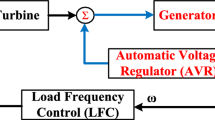Abstract
The escalating in load demand prioritized the incorporation of additional renewable energy generation plants to the existing grid. In parallel, the necessity of reactive power balance and damping characteristics has advised the incorporation of flexible AC transmission system controllers to the existing power network. Hereby, the modern power system has been driven towards the much more composite system which in turn necessitates a healthy controller technique. The objective of this paper is to contribute recommendations to incorporate robust controller technique in the field of the electrical power system. Detailed design considerations for the \(H\infty\) controller design of a modern power network have been specified, and the same has been demonstrated with mathematical modelling of power network with static synchronous compensator (STATCOM) connected in the middle of the transmission line and in a multi-machine power system. To comment on the suitability of the controller design, a deep stability analysis has been presented and compared with the traditional power system stabilizer, power system stabilizer optimized using particle swarm optimization with time-varying acceleration coefficients algorithm and whale optimization algorithm under adverse system operating conditions. The proposed controller framework has been presented by considering the case studies of single machine infinite bus system, two-machine system model and the benchmark two-area four-generator multi-machine systems connected with STATCOM. The controller performance analysis has been verified by considering eigenvalues analysis, singular value analysis and dynamic response of system states during perturbations for the first two case studies, and system analysis under faulty condition has been investigated for the multi-machine system.















Similar content being viewed by others
Abbreviations
- FACTS:
-
Flexible AC transmission system
- \(H_{2} /H\infty\) :
-
Hardy space techniques
- STATCOM:
-
Static synchronous compensator
- PSS:
-
Power system stabilizer
- SMIB:
-
Single machine infinite bus system
- VSC:
-
Voltage source converter
- LHS S-Plane:
-
Left-hand side of S-plane
- \(E_{{{\text{q}}1}}^{{\prime }} ,E_{{{\text{q}}2}}^{{\prime }}\) :
-
Internal voltage of the generator 1, 2
- E fd1 , E fd1 :
-
Field voltage of the generator 1, 2
- \(x_{{{\text{d}}1}}^{{\prime }} , \, x_{{{\text{d}}2}}^{{\prime }}\) :
-
Direct axis transient reactance of the generator 1, 2
- x d1 , x d2 :
-
Direct axis steady-state reactance of generator 1, 2
- xq1, xq2 :
-
Quadrature axis steady-state reactance of generator 1, 2
- m e :
-
Amplitude modulation ratio of STATCOM
- δ e :
-
Phase angle of STATCOM
- ω :
-
Fundamental frequency
- c dc :
-
DC link capacitor
- v dc :
-
Voltage across the DC link capacitor
- i dc :
-
Current through the DC link capacitor
- δ :
-
Torque angle/power angle
- V t :
-
Terminal voltage of the generator
- x te :
-
Transmission line reactance before STATCOM
- x bv :
-
Transmission line reactance next STATCOM
- \(T_{{{\text{d}}01}}^{\prime} , \, T_{{{\text{d}}02}}^{\prime}\) :
-
Field time constant for generator 1, 2
- T A1 , T A2 :
-
Time constant of voltage regulator for generator 1, 2
- KA1, KA2 :
-
Gain of voltage regulator for generator 1, 2
References
Aboul-Ela A, Sallam J McCalley, Fouad A (1996) Damping controller design for power system oscillations using global signals. IEEE Trans Power Syst 11(2):767–773
Adefarati T, Bansal RC (2016) Integration of renewable distributed generators into the distribution system: a review. IET Renew Power Gener 10(7):873–884
Alhelou H, Hamedani-Golshan M-E, Zamani R, Heydarian-Forushani E, Siano P (2018) Challenges and opportunities of load frequency control in conventional, modern and future smart power systems: a comprehensive review. Energies 11(10):2497
Asghari R, Mozafari B, Naderi MS, Amraee T, Nurmanova V, Bagheri M (2018) A novel method to design delay-scheduled controllers for damping inter-area oscillations. IEEE Access 6:71932–71946
Başar T, Bernhard P (2008) H-infinity optimal control and related minimax design problems: a dynamic game approach. Springer, Berlin
Bevrani H, Feizi MR, Ataee S (2015) Robust frequency control in an islanded microgrid: H∞ and μ-synthesis approaches. IEEE Trans Smart Grid 7:1–1
Buijs P, Bekaert D, Cole S, Van Hertem D, Belmans R (2011) Transmission investment problems in Europe: going beyond standard solutions. Energy Policy 39(3):1794–1801
Canizares C et al (2017) Benchmark models for the analysis and control of small-signal oscillatory dynamics in power systems. IEEE Trans Power Syst 32(1):715–722
Chatterjee D, Ghosh A (2011) Improvement of transient stability of power systems with STATCOM-controller using trajectory sensitivity. Int J Electr Power Energy Syst 33(3):531–539
Chitara D, Niazi KR, Swarnkar A, Gupta N (2018) Cuckoo search optimization algorithm for designing of a multimachine power system stabilizer. IEEE Trans Ind Appl 54(4):3056–3065
Dasu B, Sivakumar M, Srinivasarao R (2019) Interconnected multi-machine power system stabilizer design using whale optimization algorithm. Prot Control Mod Power Syst 4(1):2
Geng L, Yang Z, Zhang Y (2018) A weighting function design method for the H-infinity loop-shaping design procedure. In 2018 Chinese control and decision conference (CCDC), Shenyang, pp 4489–4493
Ghosh P, Kalwar A (2018) Application of particle swarm optimization-TVAC algorithm in power flow studies. In: Bera R, Sarkar S, Chakraborty S (eds) Advances in communication, devices and networking. Lecture notes in electrical engineering, vol 462. Springer, Singapore. https://doi.org/10.1007/978-981-10-7901-6_100
Gu D-W, Petkov PH, Konstantinov MM (2006) Robust control design with MATLAB®. Springer, Berlin
Halder A, Mondal D (2015) Design of nonlinear and conventional STATCOM controllers to mitigate transient stability of a power system. In: 2015 IEEE power, communication and information technology conference (PCITC), Bhubaneswar, India, pp 66–71
Hannan MA et al (2018) Artificial intelligent based damping controller optimization for the multi-machine power system: a review. IEEE Access 6:39574–39594
Krishna S (2014) An introduction to modelling of power system components. Springer, Berlin
Kundur P (1994) Power system stability and control. Tata McGraw-Hill Education, New York
Li XP, Chang BC, Banda S, Yeh H (1992) Robust control systems design using H-infinity optimization theory. J Guid Control Dyn 15(4):944–952
Lundström P, Skogestad S, Wang Z-Q (1991) Performance weight selection for H-infinity and μ-control methods. Trans Inst Measur Control 13(5):241–252
Miotto EL, de Araujo PB, de Fortes EV, Gamino BR, Martins LFB (2018) Coordinated tuning of the parameters of PSS and POD controllers using bioinspired algorithms. IEEE Tran Ind Appl 54(4):3845–3857
Mirjalili S, Lewis A (2016) The whale optimization algorithm. Adv Eng Softw 95:51–67
Morshed MJ, Fekih A (2019) A probabilistic robust coordinated approach to stabilize power oscillations in DFIG-based power systems. IEEE Trans Ind Inf 32:1–1
Padiyar KR (1999) Power system dynamics: stability and control. Wiley, Hoboken
Pal B, Chaudhuri B (2006) Robust control in power systems. Springer, Berlin
Patra AK, Mohapatra SK, Thakur S (2018) Application of firefly based for coordinated design of PSS and PID based SSSC-based controller. In 2018 Technologies for smart-city energy security and power (ICSESP), pp 1–7
Patwal RS, Narang N, Garg H (2018) A novel TVAC-PSO based mutation strategies algorithm for generation scheduling of pumped storage hydrothermal system incorporating solar units. Energy 142:822–837
Peres W, Silva Júnior IC, Passos Filho JA (2018) Gradient based hybrid metaheuristics for robust tuning of power system stabilizers. Int J Electr Power Energy Syst 95:47–72
Sadegh V-Z (2013) Design of power system stabilizers based on robust control theory. Iran J Sci Technol Trans Electr Eng 27(4):713–726
Safari A, Ahmadian A, Golkar MAA (2013) Controller design of STATCOM for power system stability improvement using honey bee mating optimization. J Appl Res Technol 11(1):144–155
Sahu PR, Hota PK, Panda S (2019) Modified whale optimization algorithm for coordinated design of fuzzy lead-lag structure-based SSSC controller and power system stabilizer. Int Trans Electr Energy Syst 29:e2797. https://doi.org/10.1002/etep.2797
Sahu PR, Hota PK, Panda S (2018) Modified whale optimization algorithm for fractional-order multi-input SSSC-based controller design. Optim Control Appl Methods 39(5):1802–1817
Shahalami SH, Farsi D (2018) Analysis of load frequency control in a restructured multi-area power system with the Kalman filter and the LQR controller. AEU Int J Electron Commun 86:25–46
Sharma G, Nasiruddin I, Niazi KR, Bansal RC (2016) Robust automatic generation control regulators for a two-area power system interconnected via AC/DC tie-lines considering new structures of matrix Q. IET Gener Transm Distrib 10(14):3570–3579
Souza AG, Souza LCG (2019) Design of a controller for a rigid-flexible satellite using the H-infinity method considering the parametric uncertainty. Mech Syst Signal Process 116:641–650
Tang Y, He H, Wen J, Liu J (2015) Power system stability control for a wind farm based on adaptive dynamic programming. IEEE Trans Smart Grid 6(1):166–177
Tavakoli MR, Rasouli V, Nasajpour HR, Shaarbafchizadeh M (2014) A new simultaneous coordinated design of STATCOM controller and power system stabilizer for power systems using cultural algorithm. In: 2014 IEEE international energy conference (ENERGYCON), Cavtat, Croatia, pp 446–450
Wang HF (1999a) Phillips–Heffron model of power systems installed with STATCOM and applications. IEE Proc Gener Transm Distrib 146(5):521
Wang HF (1999b) Modelling STATCOM into power systems. In: PowerTech Budapest 99. Abstract Records. (Cat. No.99EX376), Budapest, Hungary, p 302
Wang HF (2003) Modelling multiple FACTS devices into multi-machine power systems and applications. Int J Elect Power Energy Syst 25(3):227–237
Wolter JF (2017) Power generation systems with integrated renewable energy generation, energy storage, and power control. US20170117716A1
Xie W (2016) H ∞ performance realisation and switching controller design for linear time-invariant plant. IET Control Theory Appl 10(4):424–430
Zhang X, Conejo AJ (2018) Robust transmission expansion planning representing long- and short-term uncertainty. IEEE Trans Power Syst 33(2):1329–1338
Zhang W, Xu Y, Dong Z, Wong KP (2017) Robust security constrained-optimal power flow using multiple microgrids for corrective control of power systems under uncertainty. IEEE Trans Ind Inf 13(4):1704–1713
Ziaee O, Alizadeh-Mousavi O, Choobineh FF (2018) Co-optimization of transmission expansion planning and TCSC placement considering the correlation between wind and demand scenarios. IEEE Trans Power Syst 33(1):206–215
Author information
Authors and Affiliations
Corresponding author
Appendix
Appendix
1.1 Power system parameters
-
SMIB system with STACOM:
-
SATCOM parameters:
-
Cdc = 1.0 pu; Vdc = 1 pu; me = 0.7; xe = 0.15 pu
-
Synchronous Generator parameters:
-
X1d = 0.3; x1q = 0.6; M = 6.0; D = 0; xd = 1;
-
Other parameters:
-
Ka = 50; Ta = 0.01
-
Hardy Space Weighing functions:
-
W1 = []; W2 = 1 * 10−5; W3 = []
-
Two-area system with STATCOM:
-
M1 = M2 = 6.0; D1 = D2 = 0;
-
Vt1 = 1.0; Vt2 = 0.89;
-
Ka1 = Ka2 = 50; Ta1 = Ta2 = 0.01; Td011 = Td012 = 6.3;
-
xe = 0.15; x1L = 0.3; x2L = 0.3;
-
Load parameters:
-
Pe1 = Pe2 = 0.8; Qe1 = Qe2 = 0.2;
-
Hardy Space Weighing functions:
-
W1 = 0.2e−10 * (0.05 * s + 1)/(50 * s + 1); W2 = 1e−4; W3 = 0.2e−13 * (0.05 * s + 1)/(50 * s + 1);
-
Two-area four-generator system with STATCOM:
-
Xd = 1.8; Xq = 1.7; Xl = 0.2; \(X_{d}^{\prime}\) = 0.3; \(X_{d}^{\prime}\) = 0.55; \(X_{d}^{\prime\prime}\) = 0.25; \(X_{\rm q}^{\prime\prime}\) = 0.25; Ra = 0.0025; \(T_{d0}^{\prime }\) = 8; \(T_{q0}^{\prime }\) = 0.4; \(T_{d0}^{\prime \prime}\) = 0.03; \(T_{q0}^{\prime\prime}\) = 0.05; H = 6.5 (for G1, G2); H = 6.175 (for G3, G4); KD = 0
-
Base values: 100 MVA, 230 kV
-
Transmission line parameters:
-
r = 0.0001 pu/km; xL = 0.001 pu/km; bC = 0.00175 pu/km
-
Optimization Algorithm Parameters:
PSO-TVAC: | |||
Swarm size = 20 | Max_iteration = 100 | ||
wmin = 0.4 | wmax = 0.9 | ||
c1i = 2.5 | c1f = 0.2 | c2i = 0.2 | c2f = 2.5 |
WOA: | |||
SearchAgents_no = 30 | Max_iteration = 100 | ||
Rights and permissions
About this article
Cite this article
Devarapalli, R., Bhattacharyya, B. A Framework for \(H_{2} /H_\infty\) Synthesis in Damping Power Network Oscillations with STATCOM. Iran J Sci Technol Trans Electr Eng 44, 927–948 (2020). https://doi.org/10.1007/s40998-019-00278-4
Received:
Accepted:
Published:
Issue Date:
DOI: https://doi.org/10.1007/s40998-019-00278-4




